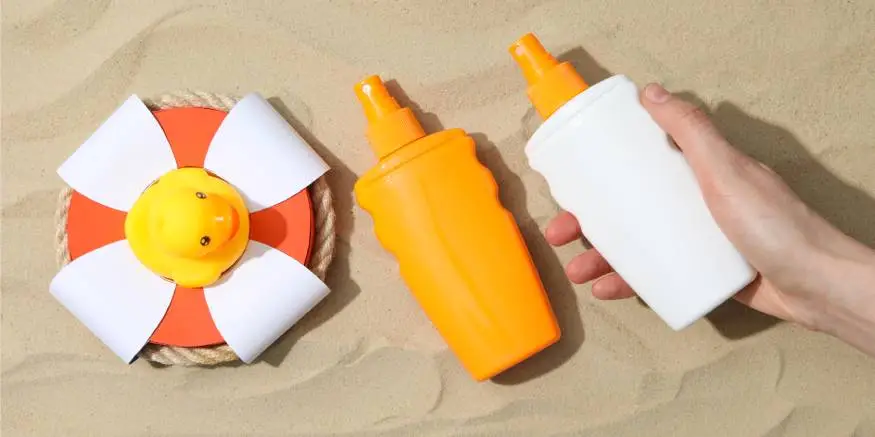Sunscreen protects your kid’s skin from the harmful UV rays of the sun and one is spoilt for choice as the market is flooded with myriad sunscreens. There are a few things to keep in mind while choosing sunscreen as all sunscreens are not created equal. It’s very important to choose a suitable sunscreen for different age groups keeping their unique needs and sensitivities in mind to ensure maximum protection.
- Choose a broad-spectrum sunscreen that offers protection against both UVA and UVB rays.
- Ensure that it is water-resistant and protects kids while in the water for 40 to 80 minutes.
- Look for a sunscreen with a SPF of 30 or higher.
- Ensure that it contains either zinc oxide or titanium dioxide as those are better for sensitive skin.
Difference Between Adult and Kid Sunscreen
- Adult sunscreen has a higher level of SPF, usually ranging from SPF 30 to SPF 50+ and offers more protection against UV rays. Kid sunscreens usually have SPF values between SPF 15 to SPF 30. This is also effective but may need more frequent application.
- The ingredients used are also different and sunscreens for kids are gentler and hypoallergenic. They usually do not contain fragrances or harsh chemicals as they can irritate their skin.
- As kids like to spend a lot of time outdoors and in the swimming pool, their sunscreen has features like water resistance.
Also Read: Infantile Acne In Babies
- Types of Sunscreen
- Mineral sunscreen
- Chemical sunscreen
There are two main kinds of sunscreen – Mineral, inorganic or physical sunscreen and chemical or organic sunscreen.
Mineral sunscreens sit on the surface of the skin and create a barrier against the sun’s rays. They usually contain zinc or titanium. These are hard to rub into the skin because their formula is designed so that it stays on the skin’s surface and may leave a whitish cast. Mineral sunscreens act almost instantly on application but come off easily with water or sweat.
Chemical sunscreens act like a sponge to absorb the sun’s rays and thus protect the skin. The sun’s rays are converted into heat and then released from the skin. It is absorbed by the top layer of the skin and so doesn’t leave a whitish cast on the skin. It starts working 15 to 30 minutes after application and doesn’t wash off easily.
Sunscreens come in the form of sprays, creams, gels and sticks. Cream sunscreens work well for those with dry skin, sticks make it easy to apply around the eyes and gels are good for hairy areas. With sprays, it’s difficult to know if one has applied enough sunscreen and its fumes can cause irritation. Some are also flammable, so shouldn’t be used around a fire.
Also Read: Tips To Protect Children From Illness Due To Seasonal Changes
Tips for Applying Sunscreen on Kids
Even the best sunscreens for kids have to be applied correctly before they give adequate protection.
- Apply daily
- Use sunscreen after babies cross 6 months
- Avoid spray-on sunscreens
- Apply sufficient sunscreen
- Reapply often
- Brief caregivers
- Sunscreen may not be enough
- Be a good role model
Irrespective of whether the sun is bright or not, sunscreen should be applied every time your kid steps outside. Even on cloudy days, 80 percent of the sun’s UV rays get through. Snow also reflects 80 percent of UV radiation.
Sunscreen should only be applied If your kid is above 6 months old. They should wear sunscreen. Below the age of 6 months, it’s better to use a wide-brimmed hat and clothing to cover their sensitive skin. Try to keep babies out of the direct sun when they are younger than 6 months old. Dress them in lightweight clothes that cover their limbs. If the sun can’t be avoided, a small amount of sunscreen on their exposed skin may be used.
Though spray sunscreens save application time, your child is at risk of inhaling harmful chemicals. Sunscreen lotions with added moisturisers are a better option for kids. Thicker and oilier lotions are more water-resistant.
It is frequently observed that parents, in many instances, fail to recognize the insufficient application of sunscreen on their offspring. Typically, the quantity required to adequately cover the exposed surfaces amounts to approximately two tablespoons. The application should be liberal. A practical guideline involves dispensing one teaspoon for the facial region and cervical area, another teaspoon for both the anterior and posterior sections of the torso respectively, an additional teaspoon for each upper limb, and finally, two teaspoons for each lower extremity.
Pay special attention to the ears, nose, neck, shoulders, behind the neck, hands and feet while applying sunscreen. Also, apply below bathing suit straps. Lip balms with SPF 30 or higher are also recommended as we often do not realise that the lips too are at risk for sunburn.
Apply sunscreen on your child 30 minutes before they go outdoors and reapply it often, about every 2 hours. Definitely reapply it after a child has been sweating or swimming.
If your child is likely to be in the care of someone else, make sure you have briefed them about applying sunscreen at regular intervals.
Parents should understand that while sunscreen is effective, other precautions to protect their child’s skin are required as well. Outdoor activities should be avoided during peak sunshine hours and encourage your child to play in the shade. Clothing that covers the skin also helps protect the skin from sunburn.
When you yourself always use sunscreen with SPF 30 or more and limit your sun exposure, it will not only benefit you by reducing your risk of sunburn, but it will also teach your kids good sun etiquette.
Also Read: Hand Sanitisers
Things to Avoid
- Do not use sunscreens containing PABA as they can be allergenic. Also, avoid sunscreens that have oxybenzone as it has hormonal properties and avobenzone is banned in some places with coral reefs because it’s ecotoxic.
- If you have sensitive skin, avoid chemical sunscreens and opt for mineral ones containing zinc oxide or titanium dioxide.
- Makeup with sunscreen is not enough sun protection for teens, urge them to apply sunscreen before any makeup.
- Do not skimp on sunscreen usage, discard any expired or three-year-old (or older) sunscreens to ensure proper protection.
In today’s world, where the options for sunscreens are countless, it might indeed be a Herculean task to choose one appropriate for your children. However, what should be understood is that the usage of sunscreen, particularly on your kids, is an uncompromising decision. It has to be used without fail, applied in good quantity and correctly and regularly. The primary concern while using sunscreen is the level of protection it offers against UV rays on your skin. For further details on selecting sunscreen for kids, you may refer to the information available on the EuroSchool website.









